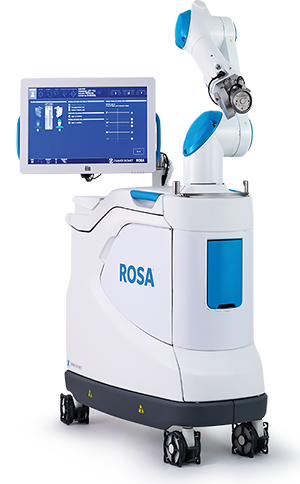Robotic Technology for Total Knee Replacement
St. Anthony Community Hospital has a new way for surgeons to help keep you moving: Robotic-arm Assisted Joint Replacement.
Robotic-arm Assisted Joint Replacement Right for You?
Osteoarthritis Sufferers
Arthritis in the knee joint
Osteoarthritis, the most common form of arthritis, is a wear-and-tear condition that destroys joint cartilage and bone. It typically develops after years of constant motion and pressure in the joints. As the cartilage continues to wear away, the joint becomes increasingly painful and difficult to move. If conservative treatment options fail to provide relief, your surgeon may recommend total knee replacement using ROSA Knee robotic technology.

How Robotic-arm Assisted Joint Replacement Works
Robotic-arm Assisted Joint Replacement Technology

Getting a precise knee implant fit is important to your comfort and
overall experience following knee replacement surgery. ROSA Knee
uses data collected before and during surgery to inform your surgeon
of many details related to your unique anatomy that may affect your
implant fit. By using this data to make more informed decisions,
your surgeon is able to plan for and carry out a personalized
surgery based upon your individual needs.
Before Surgery
Your preoperative experience will be like that of most total knee patients.
But, unlike traditional knee replacement methods, with Robotic-arm Assisted Joint Replacement Technology, a
series of x-rays may be used to create a three-dimensional (3D) model of
your knee anatomy. This 3D model will enable the surgeon to plan many
specifics of your knee replacement prior to your surgery.
During Surgery
The surgical procedure using Robotic-arm Assisted Joint Replacement Technology is similar to traditional total
knee replacement, but with a robotic assistant. Your surgeon has been
specially trained to use the robot in order to personalize the surgical
approach for your unique anatomy. It’s important to understand that
the robot does not operate on its own. That means it does not move unless
your surgeon prompts it to. Your surgeon is still in the operating room the
entire time and is making all of the decisions throughout your surgery.
During your procedure, Robotic-arm Assisted Joint Replacement Technology utilizes a camera and optical trackers
attached to your leg to know exactly where your knee is in space. Think
of it like a very detailed global positioning system (GPS) that you might
use in your car. If your leg moves even a fraction of an inch, the robot can
tell and adjusts accordingly. This helps ensure that the plan your surgeon
put into place is executed as intended. Throughout your surgery, the Robotic-arm Assisted Joint Replacement Technology provides your surgeon with data about your knee. This information,
combined with your surgeon’s skill, helps them know how to position
your implant based on your unique anatomy.
After Surgery
Following surgery, you will be hospitalized based upon the recovery plan
your surgeon decides is best for you. This hospitalization may range from
one to three days. Recovery time varies, but most people should be able
to drive after two weeks, garden after three to four weeks, and golf after
six to eight weeks. Your surgeon will tell you when and what activities
you can return to, and what activities to avoid.